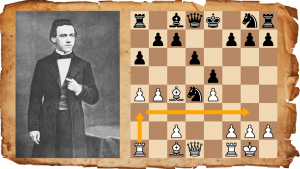
Review: The Secret Life of Bad Bishops
A former team member of mine has a favourite phrase which he likes to sing during blitz sessions with a big grin on his face: "gute Läufer, schlechte Läufer!" Referring to the legendary German grandmaster Wolfgang Uhlmann's similarly titled 1980's treatise, he annoyingly reminds his opponents of his superior bishop-handling qualities.
I'm sure he'll love Esben Lund's new and ambitious book The Secret Life of Bad Bishops, published by Quality Chess. Dealing with a single theme - the value of bishops in various stages of the game - Lund leads his readers through a wonderland of philosophical ideas, creative side-steps and concrete examples which demonstrate just how tricky it is to accurately evaluate bishops.
Lund starts out with a definition of what he calls the 'Double-edged bishop' or DEB:
"A bishop that cannot yet be declared good or bad, but rather holds the potential of becoming good as well as the risk of becoming bad."
Here's the a good example, from the Rubinstein Nimzo-Indian Defense:
Lund explains:
"The interesting strategic feature in the diagram position is the unopposed white bishop on b2, and this unique bishop is a DEB. White controls the dark squares extremely well at the moment, also due to his central pawns on c4,d4 and e3. A bishop controls one specific colour complex better than a knight, since the knight changes colour every move (...).
But the bishop's superiority on the dark squares at the same time shows a vulnerability on the opposite colour complex - the light squares. Therefore White often makes moves like Qd1-e2 and h2-h3 to strengthen his light-squared control, and he usually tries to avoid the exchange of light-squared bishops. In fact, he should carefully consider every exchange of the remaining pieces on the board (especially the minor pieces), since the DEB runs the risk of being isolated on its colour complex - and in the worst possible case ends up being a bad bishop. The DEB often shows it potential in cooperation with the other pieces and pawns."
I must admit that when I saw this example, I had the feeling that I had seen it before somewhere. After some digging, I realized I'd seen a similar case in John Watson's Chess Strategy in Action (2003). Sure enough, the very first game in the chapter called 'The Behaviour of Bishops' features the following position (note that it also arose from a Rubinstein Nimzo-Indian.):
At this point, Watson remarks:
"The very bad bishop protects the very good pawn on d4 so as to be able to play e4. It's interesting that my computer engine likes Black here in view of White's miserable-appearing bishop, slow development and Black's play down the c-file, including total control over the outpost on c4. Even the a4-pawn is weak.
But this is where the modern faith in bishops appears. Black can dance around with his knights, but unless he can find a central break to disturb the equilibirium or find squares on the king's wing, the side with the bishop can build up slowly until it becomes a superior piece."
Mihail Suba's well-known quote 'bad bishops defend good pawns' is also featured, of course, in Lund's book. Likewise, John Watson himself is quoted at length by Lund when debating the difference between bad bishops and DEB's. (Lund actually disagrees with Watson on a number of fundamental points)
The basic idea behind The Secret Life of Bad Bishops, then, is not really 'original', but in my view the way Lund treats it as a theme for an entire book, definitely is.
The main difference between Watson and Lund is that Lund extends his ideas about bishops towards the late middlegame, and especially the endgame, as well. This is something that Watson in general often doesn't do in his books, mainly focussing on opening variations and early middlegames. It is in this area that Lund reigns surpreme.
But before going there, let's quickly look at one more opening example Lund discusses extensively. Chapter 3 of the book is entirely devoted to a particular variation of the Advance French, which arises after the following moves:
The position after Black's 8th move features no less than two DEBs: the bishop on c1 as well as the bishop on c8. In the first chapter, Lund explains:
"After the exchange on f5 the black pawn structure has been blocked into pieces: d5 is isolated, and the f-pawns are doubled. (...) On the other hand, the d5 pawn is not so easy to attack, or to put it correctly it is fairly easy for Black to defend, since his DEB on c8 has got itself a home on e6. It does look very passive at e6, but it solidly gives support to all the pawns d5, f5 and f7."
(It's funny that I've known about the potential of Black's queenside bishop in such positions since the early 1990s, when I once overheard the Dutch chess player Bas van Roosmalen tell someone that in the French, 'the bishop is a beast on e6'.)
Lund gives quite an elaborate theoretical overview of the featured variation (at the same time pointing out that 'this is not an opening survey in the classical sense'), which I didn't, in all honestly, find too interesting since there is a lot of detail that seems a bit irrelevant to the topic at hand.
However, there's also a lot of good stuff in this chapter and Lund does make a real attempt to link all his analysis work back to the theme of the DEB. Moreover, it's certainly refreshing to see an author go to such lengths to show all possible angles of a particular theme, rather than just give a handful of examples and move on.
As said, it is in the chapter on endgame situations where Lund truly excels and where, in my opinion, he makes a lasting contribution to chess understanding. Essentially, Lund tries to shows how isolated bishops operate and how the nature of the position often changes from static to dynamic. It's impossible to do justice to the massive amount of situations that Lund describes in his book, so I'll just pick one theme that has always fascinated me: fortresses.
This is a fragment from his analysis of the game Balashov-Shirov, which illustrates the theme of 'fortress-like positions' or FLP's, and was, by the way, also analysed by the great Latvian player in his modern classic Fire on Board. Pay attention to the long line starting with 3.Rf8!
An absolutely fascinating piece of analysis!
There is also a chapter with exercises for the reader to solve in order to 'challenge his or her understanding of the themes presented in the book'. I tried to solve a few of them before reading the book - which I found close to impossible - and after - which was still hard, but went definitely a lot better.
The Secret Life of Bad Bishops has just under 200 pages, but contains much more food for thought that the average 350-pager. It is one of the more thought-provoking books I have read in the last 10 years or so, and after finishing it and putting it away, I couldn't help continuing to think about the subject of bad (or actually not-so-bad) bishops for a long time.
We can only hope that Esben Lund will one day write a similarly insightful book about knights.






